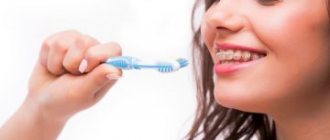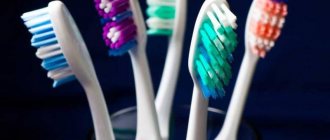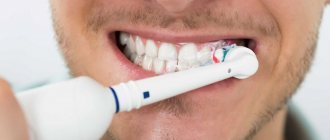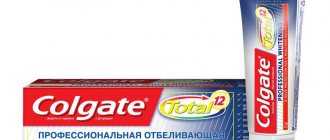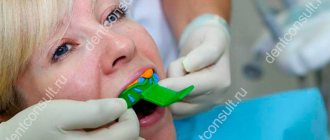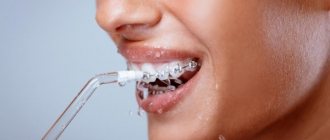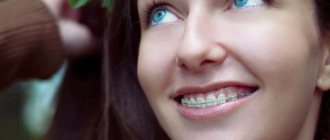Dental health largely depends on proper oral hygiene.
That is, simply brushing your teeth is not enough to completely avoid caries and other diseases. You also need to do it right. For example, using a suitable toothbrush and toothpaste. And for children, it is especially important to choose the right dental hygiene supplies. An unsuitable toothbrush is quite capable of causing acute inflammation of soft tissues, leading to damage to the enamel and forever weaning your child from regular brushing. Therefore, you need to approach its choice responsibly - even more responsibly than choosing a toothbrush for yourself.
Choosing a toothbrush depending on age
Toothbrushes for babies are completely unsuitable for preschoolers - and vice versa. Therefore, when choosing such hygiene items, you need to pay attention to the age of the child:
- Up to 1-1.5 years - silicone fingertip. This is an ultra-soft accessory that removes bacterial plaque from the first erupted teeth and gums. In this case, there is no risk of injury to the mucous membranes during use. In addition, when cleaning, such a fingertip additionally massages the soft tissues of the oral cavity, accelerating teething and making it more comfortable;
- From 1-1.5 to 3-4 years - a classic brush with a wide handle and extra soft bristles (or just soft). This is already a full-fledged hygiene accessory for independent use. In some cases it is intended to be used together with the appropriate paste. The main thing is that it is suitable for the baby;
- From 3-4 years – a classic brush with a narrow handle and soft or medium bristles. At this age, all baby teeth have already erupted, and their enamel becomes strong enough for the child to use traditional hygiene items. In addition, children from 3-4 years old can use electric toothbrushes.
When choosing a toothbrush, you should also pay attention to the individual characteristics of the child (and his environment). For example, if a small user really likes sweet, non-solid foods, such as cakes and candies, then it is better to take a model with medium bristles. And if he lives in a region with a high fluoride content in drinking or tap water, then, on the contrary, it is recommended to use brushes with soft or extra soft hardness.
Features of oral care during teething
Since everyone's teeth emerge at different times, brushing and fingertips also begin between 4 and 8 months, and in some babies as early as 1 year. Proper oral care in early childhood is the key to future health, so do not neglect the simple advice of specialists.
Babies may actively produce saliva; it must be systematically removed to prevent inflammation around the lips from developing. It is also best to purchase special teethers that the child can use independently. Silicone options can be pre-cooled in the refrigerator, but no longer than 10-15 minutes.
It is very important not to forget to lightly massage the gums; gauze or a clean soft cloth towel is suitable for this. You can also wipe your gums after each feeding, this will protect them from the accumulation of plaque and germs. The use of pastes and antibacterial solutions is not required.
Subtleties of choosing a silicone fingertip
The silicone fingertip is the very first toothbrush in a child’s life. It is clear that a one-year-old baby will not yet be able to independently engage in oral hygiene, so parents should do this for him. The accessory is put on mom or dad’s finger, after which the parent brushes the child’s teeth.
When choosing such an accessory, it is worth considering the following features:
- The product must be made entirely of silicone - even the bristles. Only in this case will it preserve the health and integrity of the soft tissues, and the parent will be able to properly control the degree of pressure;
- The fingertip should not have any noticeable seams. Bacteria and other harmful microorganisms can accumulate in such irregularities;
- It is advisable that the kit include a special case for storing the finger brush.
Before and after use, the finger brush and hands must be thoroughly washed with soap and water. No toothpaste required. Cleaning should be done slowly, using massaging rather than traditional sharp movements.
Criterias of choice
Let's look at what to pay attention to to avoid mistakes when choosing:
- Age. Be sure to choose a model based on age. A child over one year old needs a soft brush, while a child 6 years old will need a harder brush. The length of the head should not exceed 2-3 baby teeth.
- Head size. The baby should be comfortable brushing his teeth. The head should fit easily behind the cheek and not cause discomfort.
- Pen. It should fit easily and tightly in your hand so as not to slip off when working. If the handle is too large, it will be uncomfortable for the baby to use.
- Design. For the little ones, purchase a model with their favorite cartoon characters. This will turn the cleaning process into an exciting game.
- Price. Inexpensive (budget) models, made from high-quality materials and selected according to age, are in no way inferior to branded brushes. The main thing when choosing is comfort during use.
- Safety. Not all manufacturers carefully monitor the raw materials from which their devices are made. That’s why read the ingredients and ask for quality certificates from sellers.
- View. Experts offer advice on using both mechanical and electric toothbrushes. The choice depends on your individual preferences. You can try both options and choose the one that suits you.
- Functional. Many manufacturers produce models with a smartphone application, active enamel protection, etc. Decide which option is best to buy based solely on the individual needs of the baby.
- Where can I buy? Any brush can be bought in a regular store or ordered online from an online store. Be sure to check the product before paying, as the model on the website may be completely different from the one delivered.
- Popularity of models. Such models most often cost several times more than similar, but not branded, brushes. Pay attention to the quality of the material from which the brush is made. Popularity should not be the main criterion.
Our rating includes the best models, according to buyers. The basis was taken from reviews, reviews, descriptions and functionality of toothbrushes. For convenience, we divided the rating into 2 large groups: classic and electric children's toothbrushes.
Subtleties of choosing your first toothbrush
Starting from 1-1.5 years, a child can already brush his teeth independently. To do this, he will need a special brush - with a wide handle that will not fall out of his palm. The head of such cleaning accessories, as a rule, is much smaller than that of “adults”.
When choosing such a brush, you should pay attention to the following features:
- Since the enamel of the first teeth is not very developed, you cannot use brushes with hard bristles - they are quite capable of erasing the mineral layer. It is better to pay attention to soft or extra soft models;
- There should be a sufficiently wide distance between the bristles. For a 2-centimeter head, the optimal number of rows is 3-4. This will reduce the abrasive effect of the brush on the enamel;
- The size of the head depends on the age of the child. For children under 2 years old, 2-centimeter brushes are suitable. But then you can pay attention to models with a head 2-3 centimeters long.
In addition, it is desirable that the handles have rubberized inserts. This will help the child hold the brush more firmly in his hands.
The silicone fingertip does not need to be thrown away. At this age, the child cannot yet brush his teeth professionally enough, so parents may need to “finish” this “work” for him.
How does a brush motivate you to brush your teeth?
From 2–3 years old, the child begins to brush his teeth under the supervision of his parents, and from 4 years old he begins to brush his teeth independently. It is at this age that it is important to instill a healthy habit of brushing your teeth 2 times a day and brushing them correctly.
The surest way to get your child used to brushing their teeth every day is to create interest. Various interactive functions in modern electric brushes will help with this.
LED lights
Perhaps this is the first special effect that a child will appreciate. CS Medica brushes from 1 year and Mega Ten Kids Sonic from 3 years old have LED backlighting of the nozzle, which makes brushing your teeth interesting and exciting.
Smart cleaning via app
The most advanced in terms of interactivity are Philips Sonicare For Kids and Oral-B brushes.
At Philips, the brush is synchronized with a training application on a smartphone or tablet. First, an egg will appear on the screen, which you need to lightly tap with your finger. After this, a cute furry animal named Sparkly will hatch from the egg. Task: take care of and care for Sparkly. The cleaning process resembles a cartoon and is accompanied by cheerful music. The application also has a cleaning calendar and a “My Achievements” section. This way the baby is 100% involved in the cleaning process.
For Oral-B children's brushes there is a Magic Timer application with Disney characters. The timer does not synchronize with the brush, but it will teach your baby to brush for at least 2 minutes through an exciting game.
Subtleties of choosing a second toothbrush
Starting from 3-4 years old, a child can switch to more “adult” hygiene items. So, brushes with a soft or medium degree of hardness, as well as with a head 2-3 centimeters long, are suitable for it. In addition, the child can begin to use electrical hygiene products.
When choosing a toothbrush for a child aged 3-4 years, it is very important to pay attention to the design of its handle. Manufacturers like to make it “artsy”, with images of cartoon characters and so on. This is necessary so that the child perceives brushing his teeth as a game and just an interesting pastime, and not as a duty. However, especially elaborate handles can be uncomfortable, slip out of your hands or put pressure on muscles, and bacteria will begin to accumulate in their three-dimensional relief. Therefore, it is better to take a classic brush with rubberized inserts on the handle. Heroes of fairy tales and cartoons can also be drawn on it.
Come to our regional dental office. The pediatric dentist will tell you in detail about how to properly brush your child’s teeth and also select toothpaste and brush.
History of the toothbrush
Europe
In Europe, toothpicks made of gold, copper or goose feathers were used.
At first, the toothbrush became an outcast: it was believed that using this tool was indecent (as we remember, ladies and gentlemen also did not consider washing something necessary). However, by the middle of the 17th century, Chinese brushes began to gain ground. However, Europeans preferred horsehair to pig bristles because it was softer. Later, tooth powder appeared in England. It was made from clay fragments, brick powder and porcelain ground into dust; glycerin was added to improve the taste. The popularity of toothbrushes in Europe was facilitated by the appearance of the book “The Dentist-Surgeon, or a Treatise on Teeth” by the French dentist Pierre Fauchard. In his scientific work, Fauchard criticized the then prevailing opinion that the cause of dental diseases were some mysterious “tooth worms.” He identified 102 types of dental diseases and also developed a more humane method for removing teeth. The doctor also became famous for the fact that he invented false teeth, pin teeth, caps for teeth coated with porcelain enamel, and began to use primitive braces.
So, Fauchard argued that teeth must be brushed every day. True, in his opinion, horsehair, which was used in Europe to make bristles for toothbrushes, was too soft and could not clean teeth efficiently, and pig bristles, on the contrary, severely damaged the enamel of teeth. Alas, the doctor could not suggest any optimal material for bristles - his recommendations were limited to the instruction to wipe the teeth and gums with a natural sea sponge.
Humanity received proof that tooth bristles require a revolutionary new material at the end of the 19th century, when the outstanding French microbiologist Louis Pasteur hypothesized that the cause of many dental diseases are microbes and viruses. And where is it most comfortable for them to reproduce, if not in the moist environment of the natural bristles of toothbrushes? As an option, dentists suggested boiling toothbrushes daily, thereby disinfecting them, but this procedure quickly wore out the bristles and made the brush unusable.
Russia
In Kievan Rus, teeth were cleaned with oak brushes. Analogues of such brushes can be “miswak” (from the branches of the “neem” and “arak” trees).
During the reign of Ivan 4, the boyars, after eating, took out their “dental broom” - a stick with a tuft of bristles at the end.
Under Peter I, the royal decree ordered that the brush be replaced with a cloth and a pinch of crushed chalk.
In the villages, teeth were still rubbed with birch charcoal, which perfectly whitened teeth.
